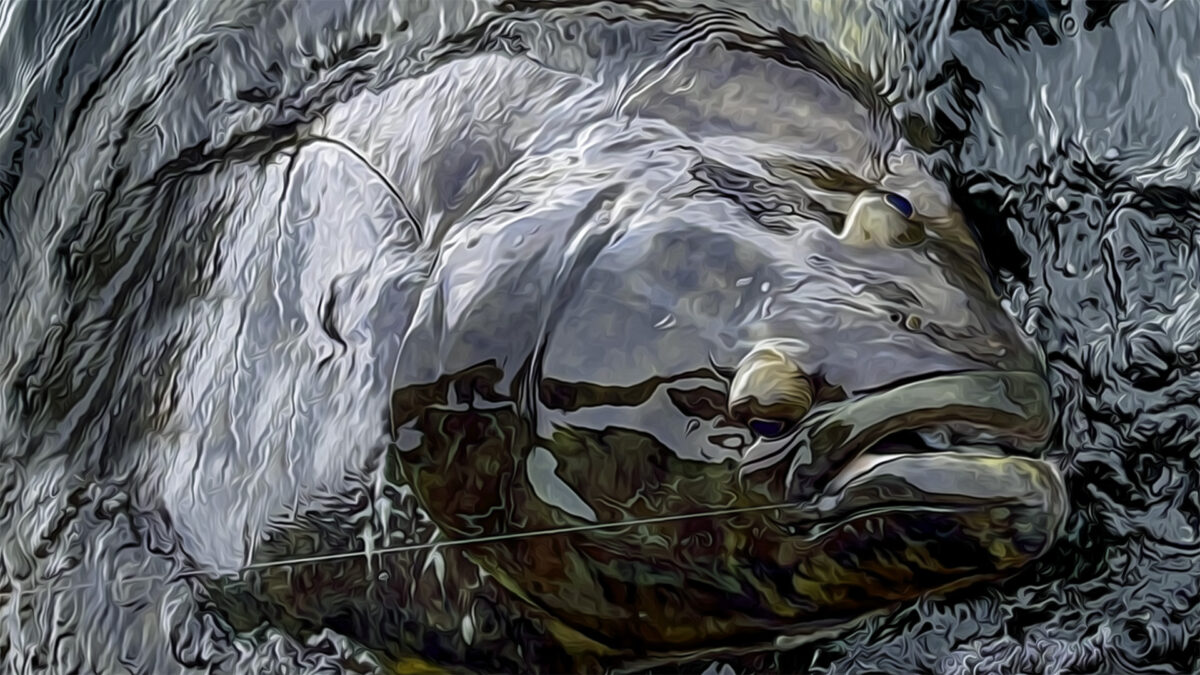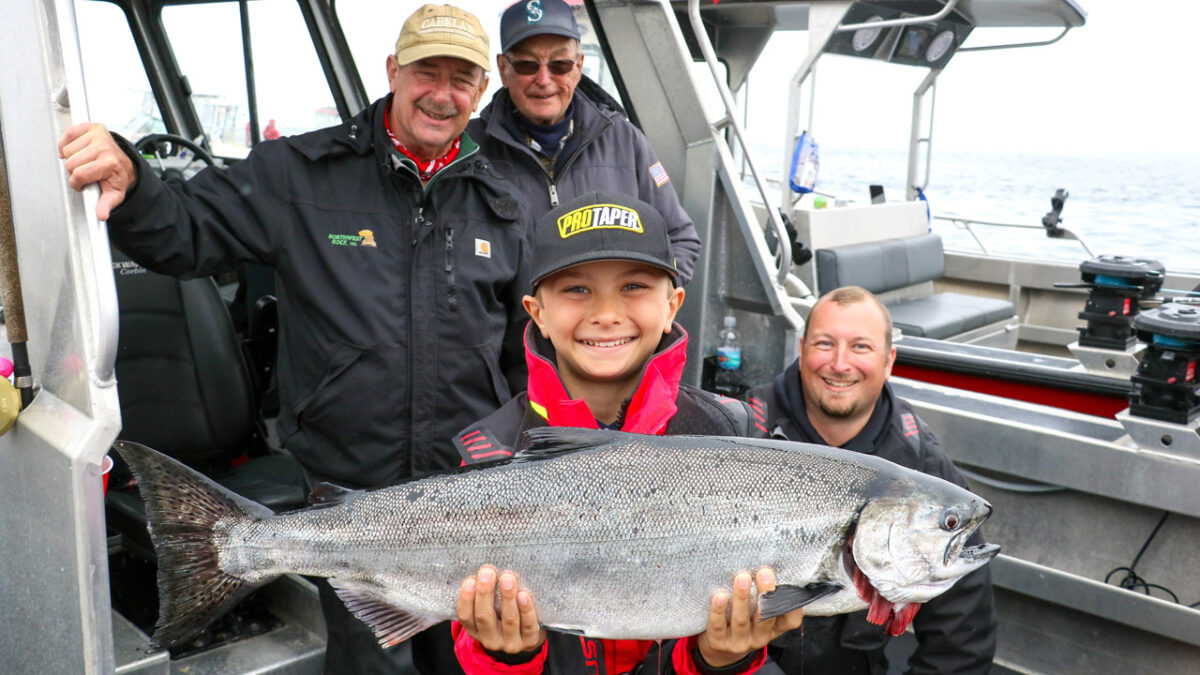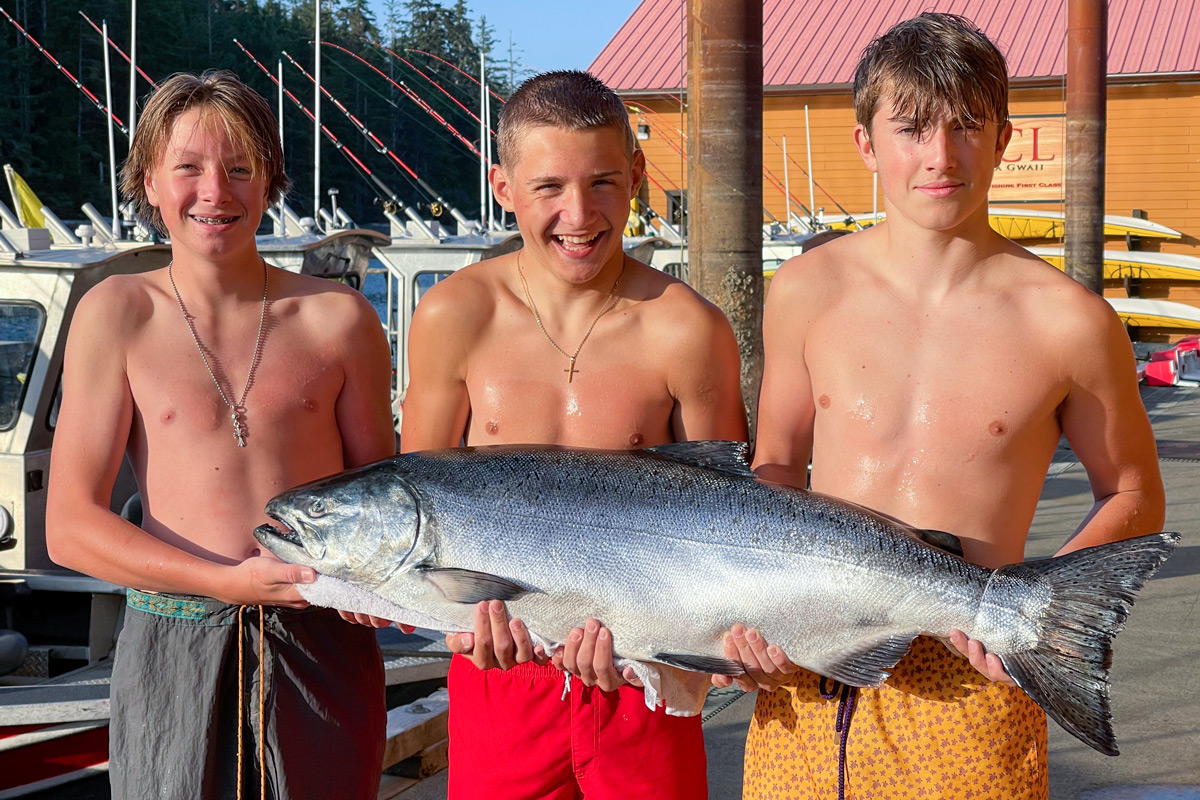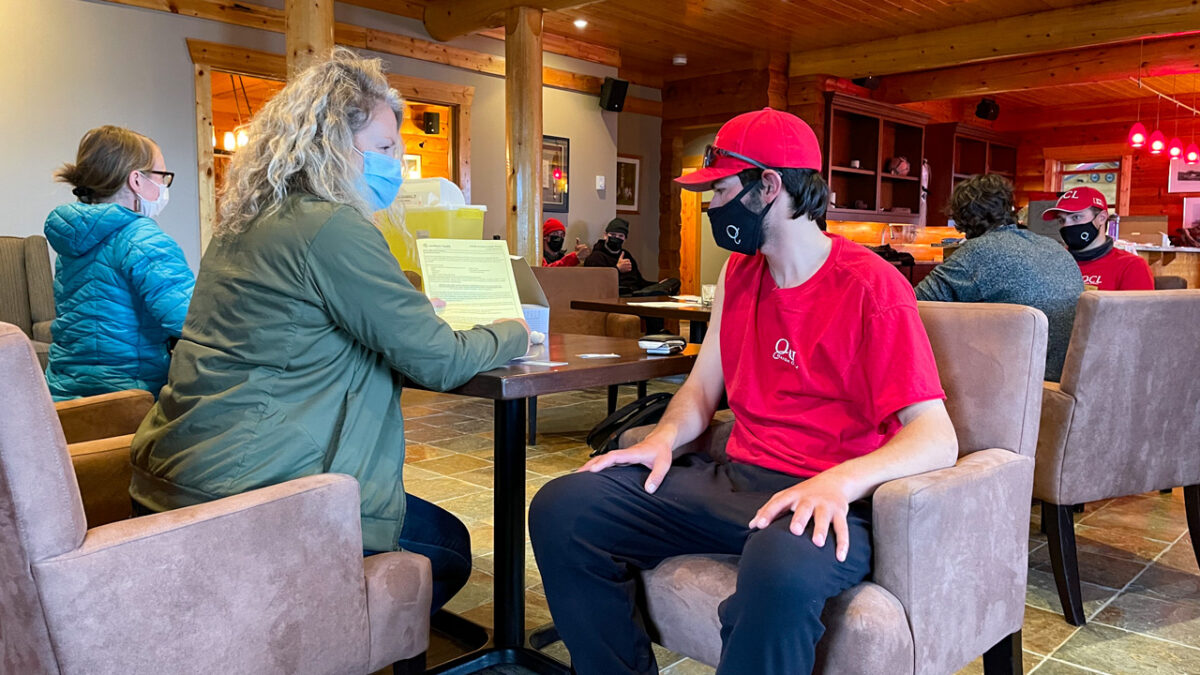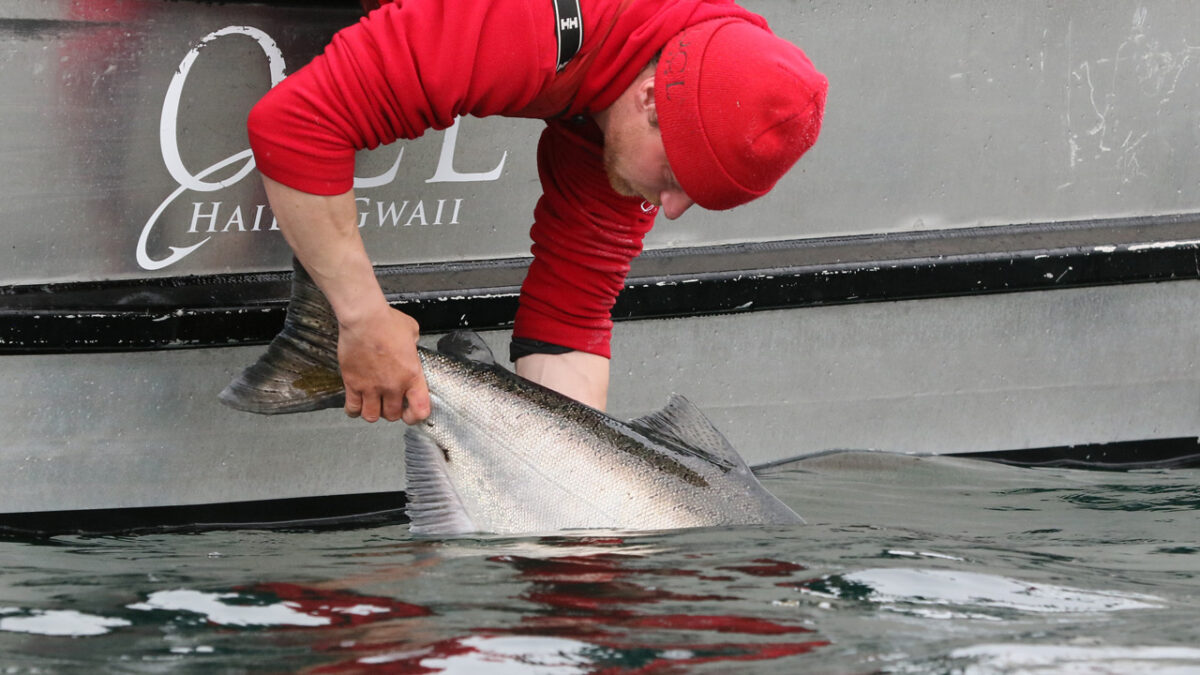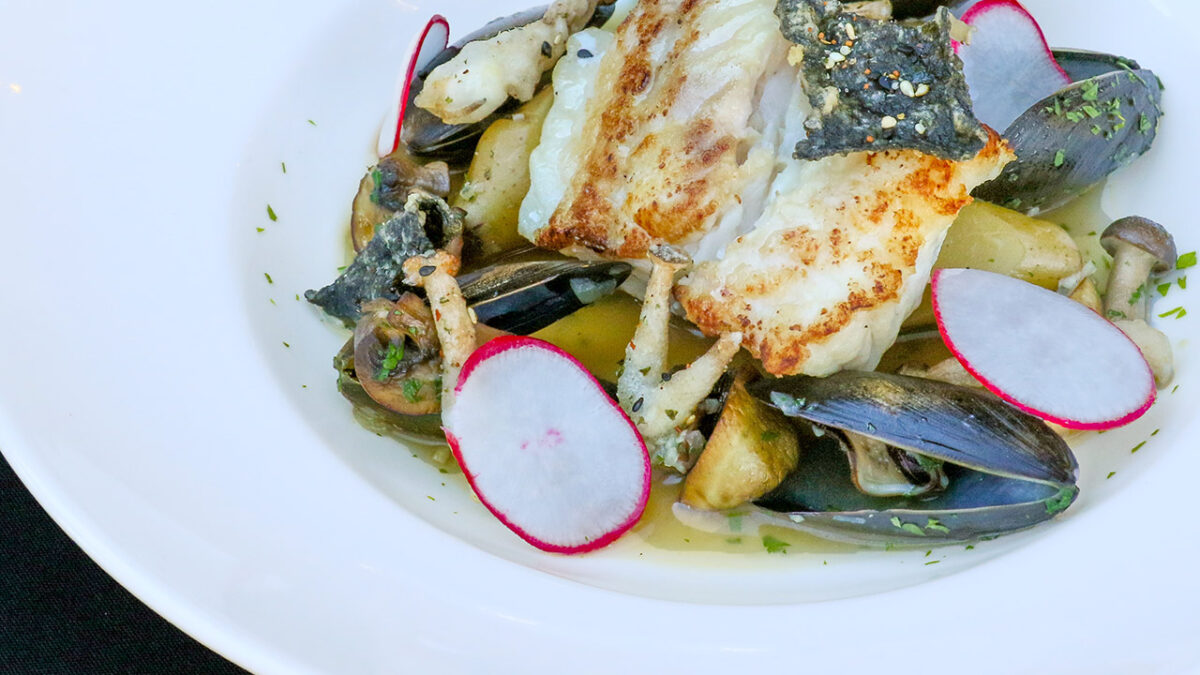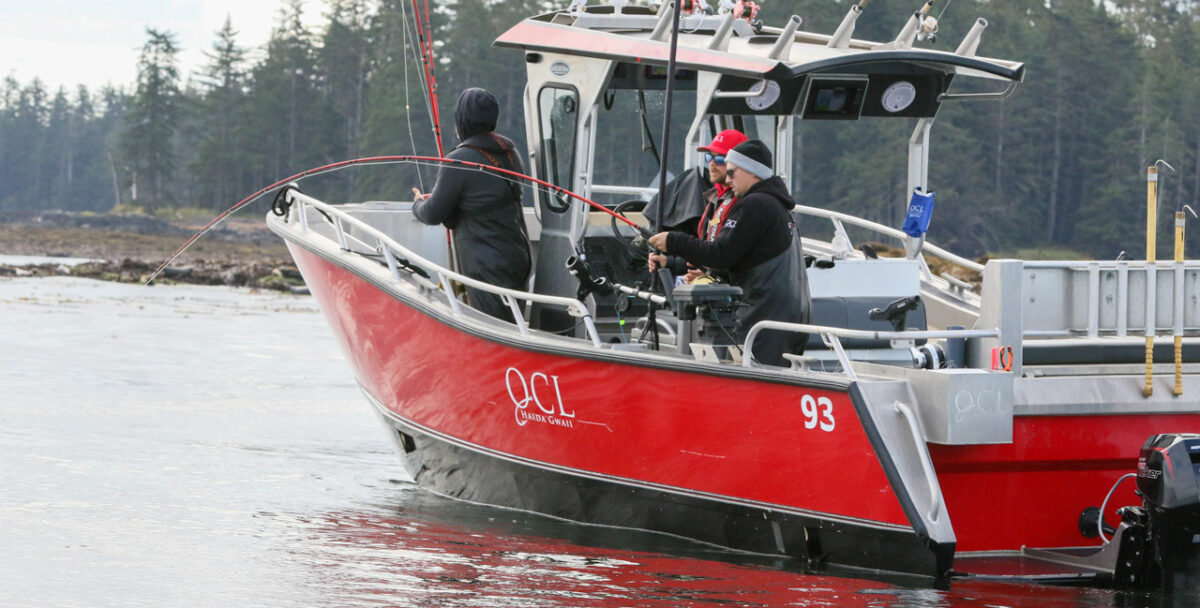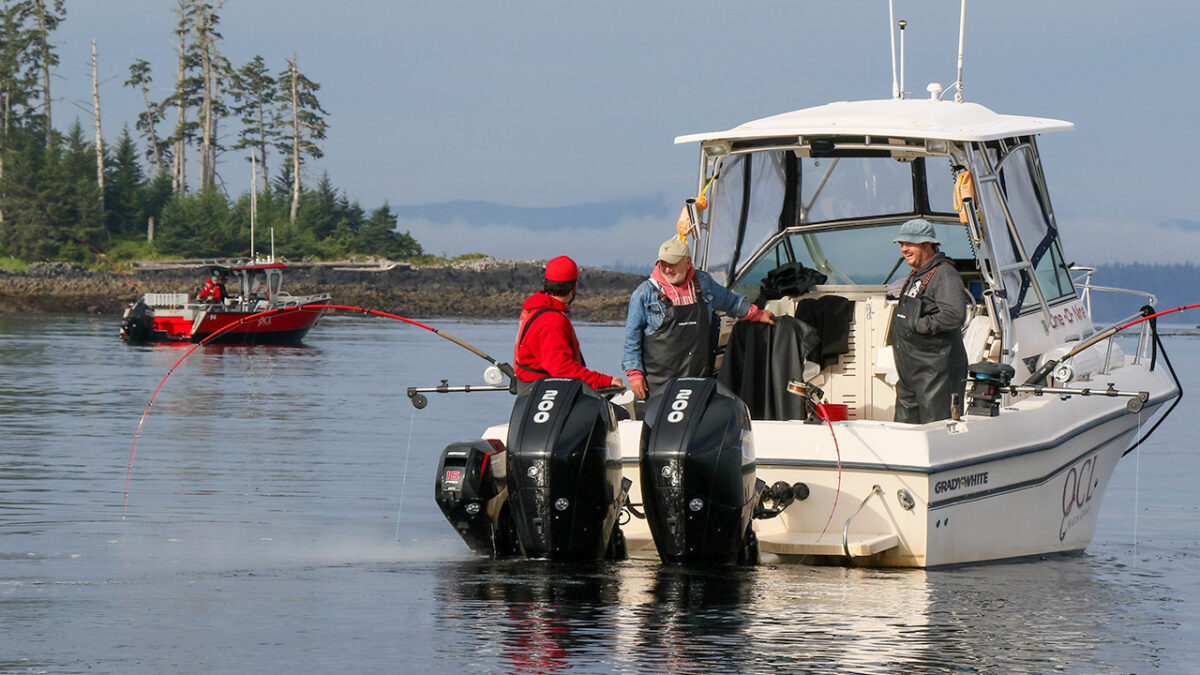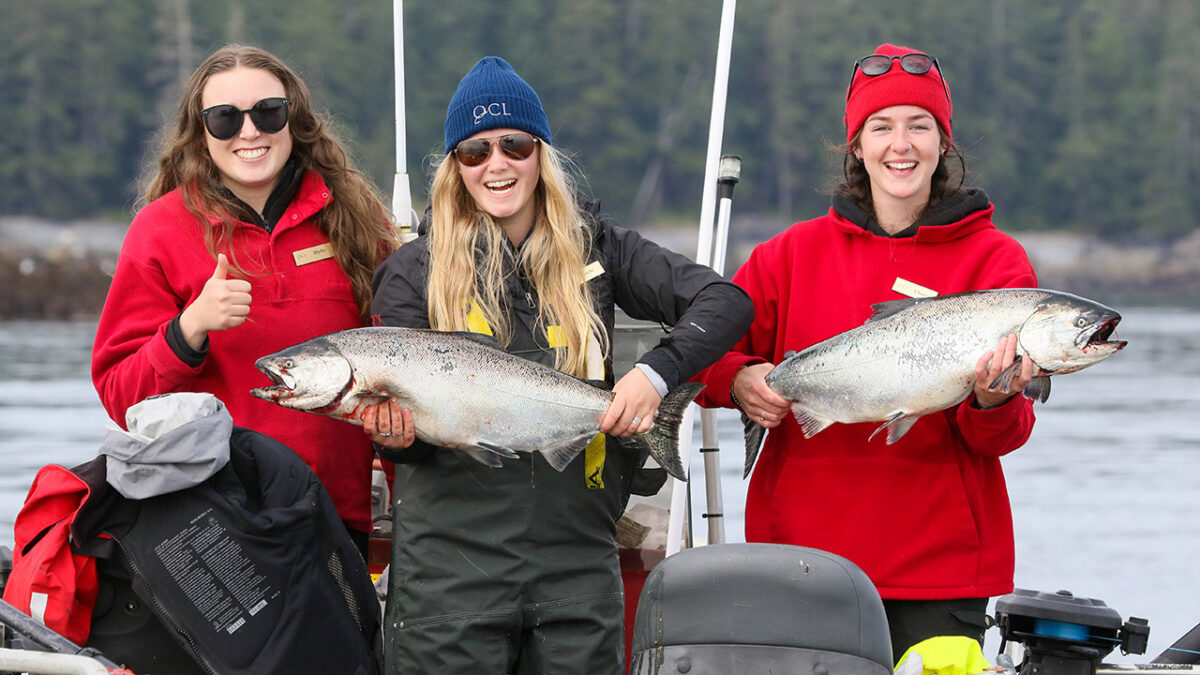Thursday September 30 is the first-ever National Day for Truth and Reconciliation, to honour the survivors of Canadian residential institutions and those who never made it home. We all know people in our community who live and struggle with the sad legacy of these schools. We all have a role to play in reconciliation. We can all listen, learn, and support the healing needed to address the intergenerational trauma caused by the residential school system. Reconciliation is not just the responsibility of government–it is a responsibility that belongs to all Canadians. The QCL office will be closed on September 30 in recognition.
It’s fair to say that most anglers who travel to Haida Gwaii on a fishing trip dream of catching a big Chinook salmon, what we call a Tyee or, as our American friends like to say, “a big Kang”! It’s easy to understand why. In these cold northern waters, they are the kings, the royalty of the fish world! Sleek and powerful and bright chrome silver, a large Chinook salmon over 30 pounds will certainly test the angler and their tackle. And it’s never over until they’re lying in the bottom of the boat!
 But if you ask these same anglers what fish they prefer on the dinner plate, the answer will often be halibut! It might be the nice meaty texture, the brilliant whiteness when it’s cooked or the subtle, non-fishy flavour and aroma of fresh-cooked halibut that holds so much appeal.
But if you ask these same anglers what fish they prefer on the dinner plate, the answer will often be halibut! It might be the nice meaty texture, the brilliant whiteness when it’s cooked or the subtle, non-fishy flavour and aroma of fresh-cooked halibut that holds so much appeal.
In our early days when we used smaller boats and engines, we had no technology like depth sounders and GPS. The halibut tackle was pretty light duty, and most anglers didn’t want to spend much time hunting for halibut. In fact, many halibut were caught as bycatch while mooching with a weighted rod for salmon! We’ve always been spoiled in Virago Sound, the halibut fishing is never too far from shore and anglers would make a quick run out to the “chicken coop” on the 180-foot line. They’d drop a herring down to the bottom and, in short order, they’d have their two fish limit – enough to keep a promise to their partner at home – and then it was back to working the kelp beds for that big Chinook.
But how the world has changed! We used to use very rough triangulation to remember our halibut holes – line up that big old spruce snag with that point over there and stay even with that big rock on the beach, and you should be close to “the spot!” Well… maybe!
Nowadays we’ve planted so many X’s on the water that pretty well everyone has their own, favourite halibut hole! Modern depth sounders synchronize with apps on your smartphone to actively upload depth and structure data to the cloud. The detailed maps created of the seafloor have revealed a whole new underwater world, out beyond the kelp beds. Sea mounts, pinnacles, rock piles and gravel benches provide habitats for all different species of fish and affect the tidal currents and feeding areas for baitfish. What was, not long ago, a great, invisible, underwater mystery, is now a seascape for exploration and discovery.
We have lots of guests up here every trip who are quite happy to spend most of their time offshore doing just that. We have larger, safer and more comfortable boats and tackle that can handle the proverbial “barn door” halibut. We’re also able to find other species like lingcod and Pacific cod. All of these fish are well managed and the limits are kept low to prevent overfishing of the stocks. And, of course, just because you know where they should be, doesn’t mean you’re going to catch them! Afterall, it’s still called fishing… not catching!
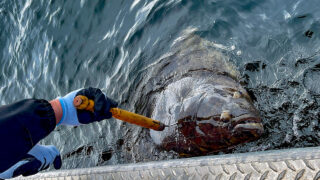 All that being said, here’s a good fish story…
All that being said, here’s a good fish story…
On Saturday morning, Curtis, Jen and Colin were salmon fishing, self-guided, near the Mazzaredo Islands. This is a location, well inside Virago Sound, where the water depth ranges between 30 and 70 feet. It’s been very productive salmon water for much of the summer, so they were trolling for Chinook salmon with cut-plug herring. Curtis had just rigged a new herring and tossed it into the water to set up the downrigger. As the herring started to sink, he noticed some movement below it and leaned over to have a better look… just in time to see the dark shadow open up to reveal a huge white mouth that inhaled his shiny herring! The shadow moved alongside the boat and then back down, flipping a wide brown tail that had to be 18-inches across! In shock, Curtis grabbed the rod from the holder and hung on. The sounder said 32-feet, so the giant fish couldn’t sound too far! But the hook was in its mouth and the 11-foot mooching rod was soon arched over in a half-circle with the line singing tight. Typically, a battle with a halibut is a weight-lifting exercise, with a short, 6-foot pool cue of a rod that bends a little at the tip. It’s often a straight lift with lots of give and take and usually happens in 200-300 feet of water, so there’s lots of lifting to do! In such shallow water Curtis’s fish had nowhere to go but out, so he held on as best he could while his boat-mates stowed the downriggers and made ready to chase down this sea monster. Fortunately for them, the tug-o-war was over in about 15-minutes as Curtis was able to maneuver the huge halibut alongside their boat; quite a feat considering the noodly salmon rod! They used another salmon rod as a measuring stick and after several attempts concluded that this giant was about six and a half feet long – 79 inches in length! It was in no mood to have anyone poking around in its mouth to retrieve the barbless bronze salmon hook so they cut the line after taking a few photos and the giant halibut disappeared as suddenly as it had arrived! A look at the IPHC Halibut Chart revealed that this big female weighed about 265 pounds! Considering where halibut usually live, Curtis’s opportunity to witness this giant take the bait was a rare occasion indeed. While it’s not unusual for us to catch halibut, even big ones, in close to shore like this, we’ve never seen one this big actually brought to the boat. Well done Curtis, Jen and Colin! Surprises like this keep us all interested and excited to get out on the water any chance we can!
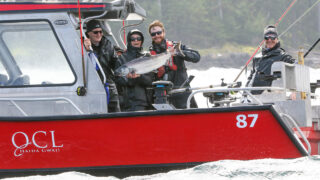 Getting away and doing something fun and exciting (or relaxing) with friends and family this summer has been the biggest goal of most of our guests. Seeing them leaving the helipad and having their first good look around is priceless… Off comes the mask, revealing a big smile, and the holiday has begun. (Not that we don’t still abide by the Covid rules – we have those too) But being in a beautiful, wild place with wide open spaces and abundant, fresh cool air is pretty exhilarating this summer!
Getting away and doing something fun and exciting (or relaxing) with friends and family this summer has been the biggest goal of most of our guests. Seeing them leaving the helipad and having their first good look around is priceless… Off comes the mask, revealing a big smile, and the holiday has begun. (Not that we don’t still abide by the Covid rules – we have those too) But being in a beautiful, wild place with wide open spaces and abundant, fresh cool air is pretty exhilarating this summer!
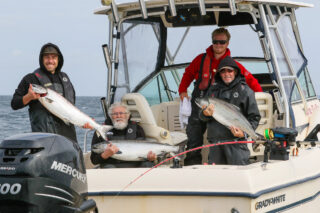 So here we are at the end of August with the end in sight; the days are shorter – off the dock at 7 am just feels weird! But we’re enjoying some really fine weather and exploring the fishing grounds in search of fish and wildlife and adventure. Chinook salmon are still turning up inshore with opportunities to tackle a Tyee, ever-present off our favourite points. Fishing with her husband and their guide Jake off Bird Rock, Nadja M boated a nice 32-pounder on Wednesday as did Leesa A with her husband and their guide Tristan at Parker Point. Anthony C landed a stunning 33-pounder on Tuesday and his wife Mimi followed suit with a 32 on Thursday, fishing with their guide Colten – quite an achievement!
So here we are at the end of August with the end in sight; the days are shorter – off the dock at 7 am just feels weird! But we’re enjoying some really fine weather and exploring the fishing grounds in search of fish and wildlife and adventure. Chinook salmon are still turning up inshore with opportunities to tackle a Tyee, ever-present off our favourite points. Fishing with her husband and their guide Jake off Bird Rock, Nadja M boated a nice 32-pounder on Wednesday as did Leesa A with her husband and their guide Tristan at Parker Point. Anthony C landed a stunning 33-pounder on Tuesday and his wife Mimi followed suit with a 32 on Thursday, fishing with their guide Colten – quite an achievement!
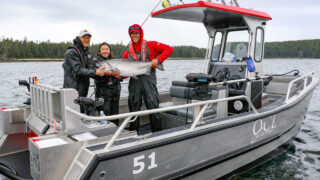 Jaxon R turned eleven on Tuesday. We were thrilled that he celebrated here at QCL with his Dad, his Grandfather and his Great-Grandfather! We are very fortunate to host family groups up here all the time – they’re a huge part of our guestlist every week. But even for us, it’s rare to see four generations all in a boat together! So the opportunity to get that photo to mark the occasion just couldn’t be missed! Jaxon provided the key to putting it all together – catching a nice shiny Chinook salmon on his birthday and the moment was preserved! We know you’ll remember it fondly Jaxon!
Jaxon R turned eleven on Tuesday. We were thrilled that he celebrated here at QCL with his Dad, his Grandfather and his Great-Grandfather! We are very fortunate to host family groups up here all the time – they’re a huge part of our guestlist every week. But even for us, it’s rare to see four generations all in a boat together! So the opportunity to get that photo to mark the occasion just couldn’t be missed! Jaxon provided the key to putting it all together – catching a nice shiny Chinook salmon on his birthday and the moment was preserved! We know you’ll remember it fondly Jaxon!
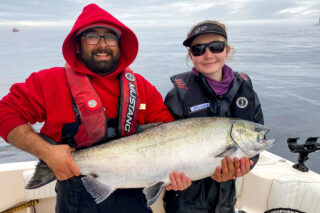 And late on Thursday, Marli J was still working the kelp beds off Yatze with her sister and her Dad, with guide DP at the helm. A year ago, they had an epic encounter with a big salmon over at Cape Edenshaw and Marli was able to catch & release a beautiful Tyee. You never expect these moments to repeat themselves but, sure enough, DP lured a big Chinook out of the kelp and it was Marli’s turn at the rod! Her deft touch was still there and with some effort they managed to boat another Tyee Chinook together. This one couldn’t be revived, as sometimes happens, but the group shared another momentous fishing experience that they’ll never forget. Whether you keep a fish, release it, or even lose it, there’s always a story that goes with it; to be shared (and maybe embellished!) with friends for years to come, and that’s one of the things we really like about fishing that never gets old!
And late on Thursday, Marli J was still working the kelp beds off Yatze with her sister and her Dad, with guide DP at the helm. A year ago, they had an epic encounter with a big salmon over at Cape Edenshaw and Marli was able to catch & release a beautiful Tyee. You never expect these moments to repeat themselves but, sure enough, DP lured a big Chinook out of the kelp and it was Marli’s turn at the rod! Her deft touch was still there and with some effort they managed to boat another Tyee Chinook together. This one couldn’t be revived, as sometimes happens, but the group shared another momentous fishing experience that they’ll never forget. Whether you keep a fish, release it, or even lose it, there’s always a story that goes with it; to be shared (and maybe embellished!) with friends for years to come, and that’s one of the things we really like about fishing that never gets old!
 We’ve been treated to some stunning moonlit nights up here for a change! You don’t realize how seldom you see the moon until it just appears one night. We’ve sure enjoyed it, but the big tides that come along with a full moon have a more dramatic effect.
We’ve been treated to some stunning moonlit nights up here for a change! You don’t realize how seldom you see the moon until it just appears one night. We’ve sure enjoyed it, but the big tides that come along with a full moon have a more dramatic effect.
Late August salmon fishing is typically divided between hunting along the rocky shores and kelp beds for big Chinooks or exploring the offshore tidelines for schools of migrating Coho. The Chinooks prefer the protective cover and like to feed during the slack periods around tide changes or they’ll often cruise the current seams and tidelines picking off baitfish getting pushed around by strong tidal flows. Tide swings of up to 16 feet this week have definitely provided those conditions! But our guides and guests have been quite successful at finding them – the Tyee Bell has been fairly noisy in celebration! 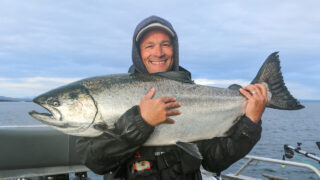 QCL guest Spencer A found a big beauty over at Slab Rock yesterday with guide Tristan O’Brian, who quickly taped the Tyee out to 43-pounds before releasing it to continue its journey to the river. Tim G landed a similar prize off Bird Rock 1 which tipped the scale at an even 40. Jeremy K released a 37-pounder at the Mazzaredos last week with guide Ryan Borschneck and Mike A boated a 35 with guide Colten Mochizuki off Parker Point. Nico B didn’t make any mistakes battling his first big salmon on the weekend and celebrated at the Bell Ringer with his friends and guide Logan Allen, joining the QCL Tyee Club with a stunning 42-pound Chinook.
QCL guest Spencer A found a big beauty over at Slab Rock yesterday with guide Tristan O’Brian, who quickly taped the Tyee out to 43-pounds before releasing it to continue its journey to the river. Tim G landed a similar prize off Bird Rock 1 which tipped the scale at an even 40. Jeremy K released a 37-pounder at the Mazzaredos last week with guide Ryan Borschneck and Mike A boated a 35 with guide Colten Mochizuki off Parker Point. Nico B didn’t make any mistakes battling his first big salmon on the weekend and celebrated at the Bell Ringer with his friends and guide Logan Allen, joining the QCL Tyee Club with a stunning 42-pound Chinook.
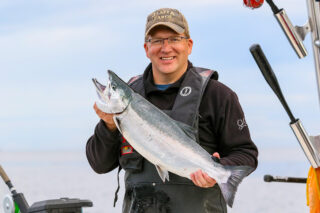 Offshore fishing has been no less productive, though the large number of Pink salmon passing through lately has certainly kept anglers out of their seats! Coho have been found mainly out over the Pinnacles and on the halibut grounds. We’re finally starting to see some of those larger, chrome bright Cohos that many of us get so excited about! Bottom fishing times have to be carefully planned during these big tides and our guide team have that schedule very well dialed. Most everyone manages to get their limit of halibut, and many are finding some of the larger “overs” in the 25-50 pound class, which is quite a thrill, and a serious workout! We haven’t been finding as many “barn doors” in the past couple of weeks but that will change next week when tide swings mellow to just 6 to 7 feet.
Offshore fishing has been no less productive, though the large number of Pink salmon passing through lately has certainly kept anglers out of their seats! Coho have been found mainly out over the Pinnacles and on the halibut grounds. We’re finally starting to see some of those larger, chrome bright Cohos that many of us get so excited about! Bottom fishing times have to be carefully planned during these big tides and our guide team have that schedule very well dialed. Most everyone manages to get their limit of halibut, and many are finding some of the larger “overs” in the 25-50 pound class, which is quite a thrill, and a serious workout! We haven’t been finding as many “barn doors” in the past couple of weeks but that will change next week when tide swings mellow to just 6 to 7 feet.
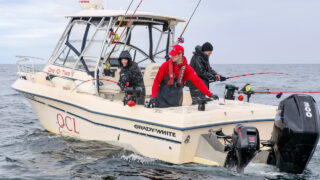 With September just around the corner, keep in mind that we’ve extended our 2021 season by 2 trips – adding a Monday-Friday trip – September 6-10 and a final weekend trip September 10-13. There’s been so much demand this summer – everybody is loving the opportunity to escape and kick back up here at The Lodge! If you can find a way, you should seriously consider jumping on one of these September trips – it’s absolutely the best way to finish the summer!
With September just around the corner, keep in mind that we’ve extended our 2021 season by 2 trips – adding a Monday-Friday trip – September 6-10 and a final weekend trip September 10-13. There’s been so much demand this summer – everybody is loving the opportunity to escape and kick back up here at The Lodge! If you can find a way, you should seriously consider jumping on one of these September trips – it’s absolutely the best way to finish the summer!
 Getting ready to open for our 2021 season, one major consideration was having our staff vaccinated to ensure their safety and that of our guests and the community. With some effort on everyones part, we’re proud to say that we got it done before they came up to the lodge. But we’d only been open a few days when we realized that the “second jab” would come due for each of them all throughout the summer. Of course, in a location as remote as Naden Harbour, mobility is a major challenge, but we had to find a solution.
Getting ready to open for our 2021 season, one major consideration was having our staff vaccinated to ensure their safety and that of our guests and the community. With some effort on everyones part, we’re proud to say that we got it done before they came up to the lodge. But we’d only been open a few days when we realized that the “second jab” would come due for each of them all throughout the summer. Of course, in a location as remote as Naden Harbour, mobility is a major challenge, but we had to find a solution. Preparations were all made in advance and the medical team was picked up and delivered to the lodge where they set up their makeshift vaccination clinic in the Totem House lounge. Over the 8-hour schedule we managed to provide that critical second dose of vaccine to more than 100 of our staff from every department. The nurses even did live updates to the database so every staff received a notification confirming their vaccination. We pride ourselves on service and can happily verify that this team from Masset went above and beyond to take care of our staff… top shelf! Thank you so very much!
Preparations were all made in advance and the medical team was picked up and delivered to the lodge where they set up their makeshift vaccination clinic in the Totem House lounge. Over the 8-hour schedule we managed to provide that critical second dose of vaccine to more than 100 of our staff from every department. The nurses even did live updates to the database so every staff received a notification confirming their vaccination. We pride ourselves on service and can happily verify that this team from Masset went above and beyond to take care of our staff… top shelf! Thank you so very much!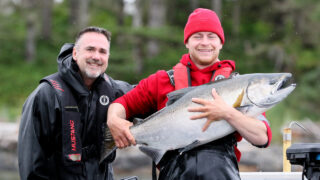 QCL anglers have enjoyed the best of both worlds recently with a return to our traditional summer westerlies but avoiding those big water days that can restrict access to the fishing grounds. The salmon action has been quite consistent with anglers fishing all their favourite spots from Green Point all the way back to the Mazzaredos. Bigger tides over the past week have helped to turn on “the bite” at various times of day and our guests are having good success with Chinook catches inshore. While we’re still seeing lots of teen-sized feeders there have definitely been more twenty-somethings and Tyee-class fish in the mix.
QCL anglers have enjoyed the best of both worlds recently with a return to our traditional summer westerlies but avoiding those big water days that can restrict access to the fishing grounds. The salmon action has been quite consistent with anglers fishing all their favourite spots from Green Point all the way back to the Mazzaredos. Bigger tides over the past week have helped to turn on “the bite” at various times of day and our guests are having good success with Chinook catches inshore. While we’re still seeing lots of teen-sized feeders there have definitely been more twenty-somethings and Tyee-class fish in the mix. 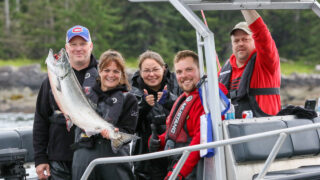 The stretch of awesome Virago Sound shoreline from “the Mazz” around to Bird 2 has turned out a lot of good fish this season, especially over the past 10 days. Tim C, with his QCL guide Shawn Breau, did the dance with a powerful big Chinook at the Mazz last night before Shawn was able to get the net under it and finally have a good look. Tim knew this fish had to get to the river and easily decided to let him go. A couple of quick pics and Shawn soon had this beauty back on its way. Great work guys – Congratulations Tim!
The stretch of awesome Virago Sound shoreline from “the Mazz” around to Bird 2 has turned out a lot of good fish this season, especially over the past 10 days. Tim C, with his QCL guide Shawn Breau, did the dance with a powerful big Chinook at the Mazz last night before Shawn was able to get the net under it and finally have a good look. Tim knew this fish had to get to the river and easily decided to let him go. A couple of quick pics and Shawn soon had this beauty back on its way. Great work guys – Congratulations Tim!
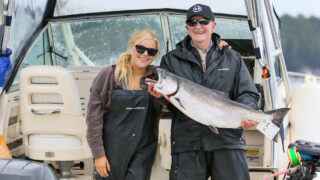 The Tyee bell has certainly been noisy this week with quite a few big fish being celebrated, some released and some coming back to the dock. Reports of huge halibut catches are down recently with the bigger tides being a factor, but everyone is getting out to pick up some nice keepers to take home. The average is still around 15 pounds but we’re seeing several chunky ‘buts between 30 and 60 pounds on the scale every trip. Coho fishing has come on strong in the offshore waters and it doesn’t take long to pick up a few nice ones. We’re finding them from the 100 foot line all the way out to the Pinnacles and 250+ feet of water, fishing down 40-60 feet seems most consistent. Coho in the double-digits are becoming more common now and Scott N boated a beautiful 14-pounder last week, so those amazing & feisty Northerns are starting to show up. They have a huge fan club and we can’t wait to see more!
The Tyee bell has certainly been noisy this week with quite a few big fish being celebrated, some released and some coming back to the dock. Reports of huge halibut catches are down recently with the bigger tides being a factor, but everyone is getting out to pick up some nice keepers to take home. The average is still around 15 pounds but we’re seeing several chunky ‘buts between 30 and 60 pounds on the scale every trip. Coho fishing has come on strong in the offshore waters and it doesn’t take long to pick up a few nice ones. We’re finding them from the 100 foot line all the way out to the Pinnacles and 250+ feet of water, fishing down 40-60 feet seems most consistent. Coho in the double-digits are becoming more common now and Scott N boated a beautiful 14-pounder last week, so those amazing & feisty Northerns are starting to show up. They have a huge fan club and we can’t wait to see more!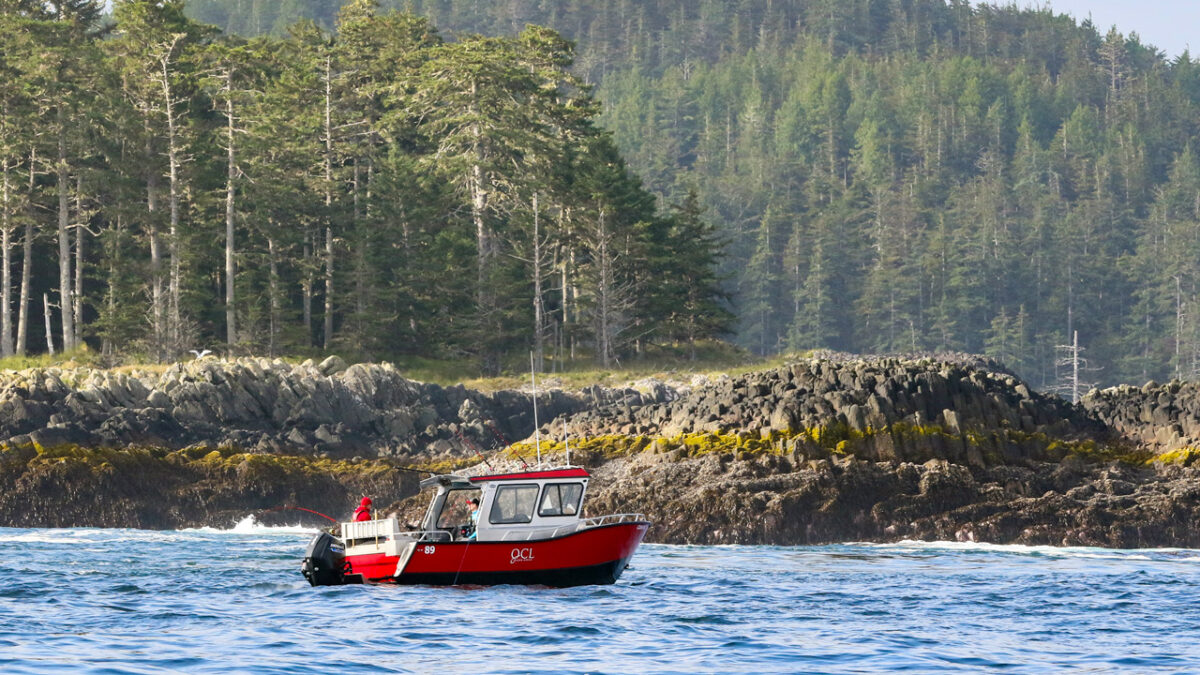
A challenging but very rewarding fishery here at Queen Charlotte Lodge is the search for lingcod near the underwater peaks and shelves that litter the ocean floor. Feeding on the flood, these aggressive predators snap at nearby bait and lures alike with their powerful jaws and gripping front teeth. Nothing prepares you for the first time you haul up a large ling-dinger and see the head emerge out of the dark depths as you crank away on your sturdy Avet saltwater reel!
Before coming to work at QCL in 2017, most of my saltwater fishing experience consisted of chasing around small lingcod with buzzbombs in the inshore waters of British Columbia’s Sunshine Coast region. From my dad, I learned to gut and clean my catch, and how to carefully separate the filets from the carcass. We’d cook the ling with lemon and butter, perhaps some parsley or tarragon if we were feeling adventurous.
Just as my lingcod fishing has evolved, so too has my culinary technique; in the kitchen today, we don’t just stop at lemon, butter and herbs for our lingcod dish. Inspired by similar latitudes on the other side of the North Pacific, the lingcod dish I chose to serve at QCL fuses local line-caught lingcod with Japanese ingredients and techniques for a dish packed with flavour and steeped with memories.
We start by making the tentsuyu broth, which is a slightly sweet Japanese broth commonly served with fried tempura items like tofu, vegetables or ebi. The broth starts with simmering shitake mushrooms, to which we add kombu (a dried kelp), mirin (sweet cooking wine), rice wine vinegar and tamari (gluten free soy sauce). Once these ingredients have begun to release their impressive flavours, we briefly add and steep some katsuobushi (dried and smoked bonito flakes). After ten minutes we remove the bonito and simmer the broth for another thirty minutes. The combination of kombu, katsuobushi, and mushrooms imparts an intense umami flavour. Umami is that meaty, savoury mushroomy-anchovy-raw tuna hard to quantify but “you know it when you taste it” taste.
Once our broth is prepared, the rest of the dish comes together quite quickly. Into a hot blue-steel pan we add a tablespoon of grapeseed oil, chosen for its neutral flavour and relatively high smoke point. Our lingcod filet is then slid into the hot pan, with the side first touching the pan intended to be our presentation side once all the cooking is complete. After a few minutes, gently flip the lingcod, and reduce the heat to the pan to just cook the fish through to medium-moist. You don’t want to overcook this lean white fish!
In another hot pan we start a brief sauté of sofrito (onions, garlic, and olive oil), into which we add a season mix of mushrooms, including chanterelles, baby king oyster, maitake (hen of the woods) and shimeji, as well as five Salt Spring Island mussels. After one minute, we add three halved fingerling potatoes which have been braised with some of the tentsuyu broth sous vide (under vacuum) in an immersion circulator. The potatoes are packed with that umami flavour and form the base for the plating of the dish. A short simmer with some vegetable stock under a lid to open the mussels and heat the potatoes through and we are ready to plate.
Into a wide bowl we evenly distribute the halved potatoes, forming a base upon which we can build some height and drama for the finished dish. Naturally allow the mushrooms to fall around the potatoes, settling into the bottom of the bowl. The mussels are placed around the potatoes, showcasing the delicious bite within each shell. On top of this umami platform, we place the just-cooked lingcod filet, crispy golden side up.
The final stage of the dish involves the garnishes, of which there are three. First, we do a quick pickle of thinly sliced radish, just a minute or so in a combination of rice wine vinegar, mirin and a touch of Maldon salt (a large-flaked English sea salt). As the radishes are absorbing the slightly sweet and acidic pickle, we quickly dip a cluster of enoki mushrooms and a few slices of wakame or yakinori (both types of seaweed packed with umami) in a loose tempura batter, and quickly fry them until crispy and golden brown. A quick toss in some house made furikake (a Japanese spice mix consisting of bonito flakes, seaweed, sesame seeds, sugar and salt) and our crispy nori and mushroom hay is ready to crown the piece of fish. The radishes are naturally set up against the other ingredients to showcase their colour contrast and provide some freshness, as well as some balance to the other flavours.
Once we have assembled the stacked potatoes, mussels, mushrooms, seared fish, and garnished with our pickles and crispy components, the last thing to do is to pour some piping hot tentsuyu broth into the bottom of the bowl. The heady aromas, intense layers of umami, seared and flaky white fish, lightly pickled radish, and fun and frivolous crispy tempura garnish are all essential parts to one of my favourite, and deeply personal, dishes on the QCL menu this year.
QCL Chef Chris Green
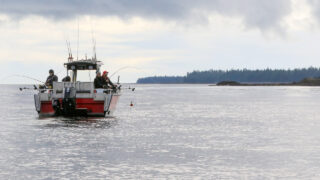 With the morning light just starting to dawn, my guests and I decided to leave the dock as early as possible. But we weren’t alone and one quick boat steered towards our fishing spot of choice. Fortunately they changed their minds and we got there with the spot untouched. With a purple dawn barely broken and not a breath of wind disturbing the waters, a magic hour was upon us. Our lines not yet in the water, we knew the bite was going to be swift upon us. “First boat, first pass!” I said to my guests.
With the morning light just starting to dawn, my guests and I decided to leave the dock as early as possible. But we weren’t alone and one quick boat steered towards our fishing spot of choice. Fortunately they changed their minds and we got there with the spot untouched. With a purple dawn barely broken and not a breath of wind disturbing the waters, a magic hour was upon us. Our lines not yet in the water, we knew the bite was going to be swift upon us. “First boat, first pass!” I said to my guests. 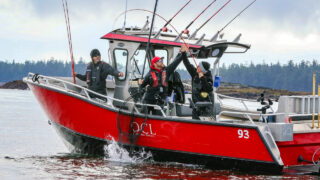 The first salmon we hooked immediately but she slipped the hook after steaming sideways next to the boat. We reset our lines and although there was a wait, we boated two nice Chinook salmon! Streaks on the sonar, calm water and the laughter created by the odd salmon biting our gear set the tone for the day. Excited to capitalize on our time on the water, we took advantage of a to-go order on the lunch boat, the M.V. Driftwood. Loaded with hot burgers cold beverages on the boat, we fished the day away, enchanted by the surrounding trees, waves, and rocks offered by the northern coast of Graham Island. Don’t worry, we topped the day off with a sighting of orcas dipping and fishing their way eastbound along the coast.
The first salmon we hooked immediately but she slipped the hook after steaming sideways next to the boat. We reset our lines and although there was a wait, we boated two nice Chinook salmon! Streaks on the sonar, calm water and the laughter created by the odd salmon biting our gear set the tone for the day. Excited to capitalize on our time on the water, we took advantage of a to-go order on the lunch boat, the M.V. Driftwood. Loaded with hot burgers cold beverages on the boat, we fished the day away, enchanted by the surrounding trees, waves, and rocks offered by the northern coast of Graham Island. Don’t worry, we topped the day off with a sighting of orcas dipping and fishing their way eastbound along the coast.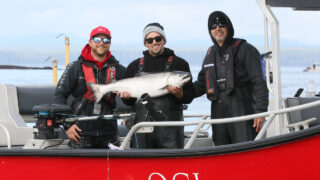
– Logan Allen
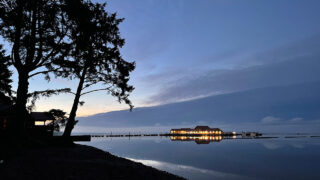 Every angler has their favourite time to go fishing… “Anytime” is the answer for most! But there are a lot of QCL guests who just love August. Maybe it’s the warmer weather, the bigger Coho, the later starts… certainly there all kinds of reasons. For this year, we’re now at the halfway point of our season, due to the late start on July 2nd, and we’re happy to report that everything is ticking along very nicely.
Every angler has their favourite time to go fishing… “Anytime” is the answer for most! But there are a lot of QCL guests who just love August. Maybe it’s the warmer weather, the bigger Coho, the later starts… certainly there all kinds of reasons. For this year, we’re now at the halfway point of our season, due to the late start on July 2nd, and we’re happy to report that everything is ticking along very nicely.
 On the fishing front, we’re currently seeing a nice bump in the number of larger Chinooks, with the Tyee bell getting a workout each evening. Big fish are especially celebrated and those over 40 pounds are revered. On the weekend, self-guided guests Sasha and Brandi spent some quality time at Klashwun Point with a beautiful big Tyee that they taped out to 42 pounds before carefully sending it back on its homeward journey. Nicely done you two! Jeff F and his buds had a pretty fine day fishing with QCL guide Tristan O’Brian, with Jeff boating a chunky 46-pound halibut and releasing an awesome Chinook that scored 34 pounds.
On the fishing front, we’re currently seeing a nice bump in the number of larger Chinooks, with the Tyee bell getting a workout each evening. Big fish are especially celebrated and those over 40 pounds are revered. On the weekend, self-guided guests Sasha and Brandi spent some quality time at Klashwun Point with a beautiful big Tyee that they taped out to 42 pounds before carefully sending it back on its homeward journey. Nicely done you two! Jeff F and his buds had a pretty fine day fishing with QCL guide Tristan O’Brian, with Jeff boating a chunky 46-pound halibut and releasing an awesome Chinook that scored 34 pounds. 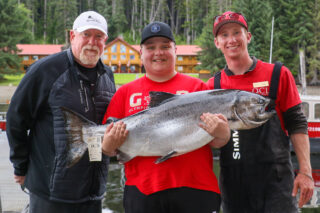 We saw a couple of big chrome beauties on the dock this week with Tom S boating a handsome 47 lb. Tyee with guide Craig Wensel and Taylor H, fishing with his Grandad, caught the fish of a lifetime in a 43-pounder with guide Noah Crumb at the helm.
We saw a couple of big chrome beauties on the dock this week with Tom S boating a handsome 47 lb. Tyee with guide Craig Wensel and Taylor H, fishing with his Grandad, caught the fish of a lifetime in a 43-pounder with guide Noah Crumb at the helm.
The light southerly winds have continued to provide easy and comfortable access to the offshore waters and every angler is getting lots of opportunity to get down for some nice halibut and lingcod. We get reports of several big hali’s over 100-pounds hooked each week but most everyone is having a good time pulling up some nice keepers between 15 and 50 pounds. Getting over the pinnacles to catch your first lingcod is generally an easy feat, while finding that spot again for a second one is the bigger challenge! That’s why we call it fishing!
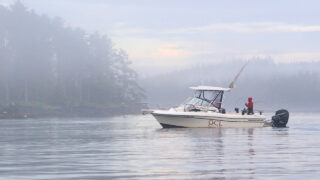 While we’ve been enjoying a lot of calm water over the past couple of weeks we are looking forward to a general shift to westerly winds for the coming days. We find that southerlies tend to disperse the feed, and the fish, while west and northwesterlies bring everything back closer to shore and concentrates the salmon fishing noticeably. We’ll soon see if that rings true in the early days of August! Stay tuned!
While we’ve been enjoying a lot of calm water over the past couple of weeks we are looking forward to a general shift to westerly winds for the coming days. We find that southerlies tend to disperse the feed, and the fish, while west and northwesterlies bring everything back closer to shore and concentrates the salmon fishing noticeably. We’ll soon see if that rings true in the early days of August! Stay tuned!
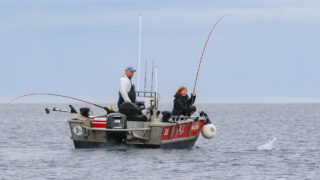 As we flip the page on July, we’re well into a typical midsummer fishery with the bulk of our Chinook salmon found in closer to shore and feeding schools of Coho ranging throughout the offshore grounds in water depths of 120-250 feet. Depending on the day and the light, we’re finding the Coho anywhere from the surface down 100 feet or so. While the typical Coho is still in the 7-9 pound class we’re starting to get some over 10 and that will continue to increase through September.
As we flip the page on July, we’re well into a typical midsummer fishery with the bulk of our Chinook salmon found in closer to shore and feeding schools of Coho ranging throughout the offshore grounds in water depths of 120-250 feet. Depending on the day and the light, we’re finding the Coho anywhere from the surface down 100 feet or so. While the typical Coho is still in the 7-9 pound class we’re starting to get some over 10 and that will continue to increase through September.
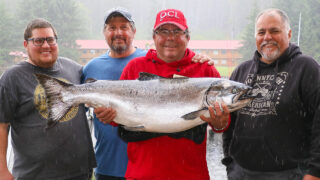 Our Chinook fishery in July was dominated by large numbers of feeder Springs feeding in close along with the other 4 species of salmon. It was a total jackpot, and you never knew what was going to hit your gear. But with no significant winds in the area for about 10 days now, the fish and bait have dispersed widely throughout the grounds. The flat calm seas have enabled anglers to venture out to find the fish and they’ve been quite successful.
Our Chinook fishery in July was dominated by large numbers of feeder Springs feeding in close along with the other 4 species of salmon. It was a total jackpot, and you never knew what was going to hit your gear. But with no significant winds in the area for about 10 days now, the fish and bait have dispersed widely throughout the grounds. The flat calm seas have enabled anglers to venture out to find the fish and they’ve been quite successful.
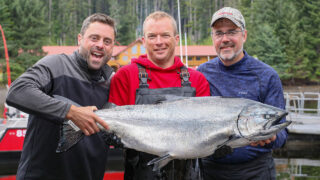 Tides have also played a significant role and guides are religious about picking their favourite points and fishing them hard through the slack. And the rewards have been significant! Cape Naden turned out the top fish this week with a stunning big Chinook caught by Nicole C that taped out to 50 pounds before being carefully released by her guide Len! Nice work you two! Tuesday was a big day with a pair of 41 pounders arriving in the Bell Ringer. One was boated at first light by veteran angler Mike C, fishing with QCL guide Ken Lepage. The other big beauty was landed by Frances D at Cape Naden at the end of the day with his senior QCL guide Ryan Kelly. “Just one more pass” does it again! Congratulations!
Tides have also played a significant role and guides are religious about picking their favourite points and fishing them hard through the slack. And the rewards have been significant! Cape Naden turned out the top fish this week with a stunning big Chinook caught by Nicole C that taped out to 50 pounds before being carefully released by her guide Len! Nice work you two! Tuesday was a big day with a pair of 41 pounders arriving in the Bell Ringer. One was boated at first light by veteran angler Mike C, fishing with QCL guide Ken Lepage. The other big beauty was landed by Frances D at Cape Naden at the end of the day with his senior QCL guide Ryan Kelly. “Just one more pass” does it again! Congratulations!
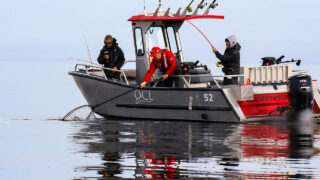 The big halibut keep on coming each trip and this week was no exception. Dominique P hauled up a nice chunky fish that scored 116 pounds and Mark L had a good closeup look at a 180-pounder. Driftwood anglers David L and partner Ken K did their best to measure an absolute giant that David successfully hauled to the surface. At 200 cm in length their proverbial “barn door” scored 263 pounds! Now that’s a workout! Great fishing guys!
The big halibut keep on coming each trip and this week was no exception. Dominique P hauled up a nice chunky fish that scored 116 pounds and Mark L had a good closeup look at a 180-pounder. Driftwood anglers David L and partner Ken K did their best to measure an absolute giant that David successfully hauled to the surface. At 200 cm in length their proverbial “barn door” scored 263 pounds! Now that’s a workout! Great fishing guys!
We’re ready for the return of some steady northwesterly weather that tends to push the bait, and the fish, back onshore. But there’s none in the forecast for the coming week – a little light westerlies and then some southeast. Fortunately, we’re still finding pockets of bait out there and QCL anglers are having a great time tracking down some awesome fish to take home. Stay tuned! August is almost here!


